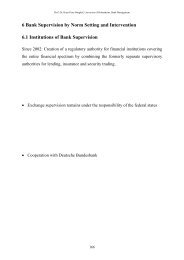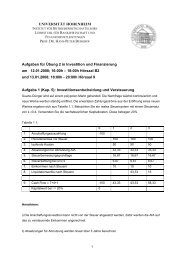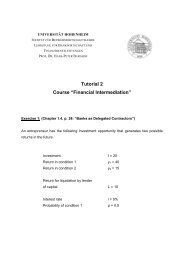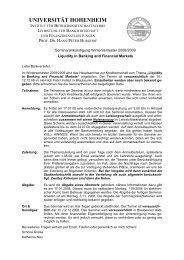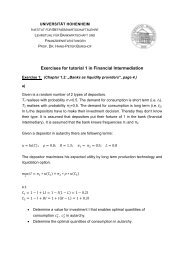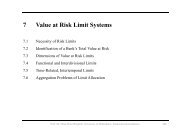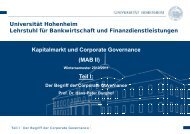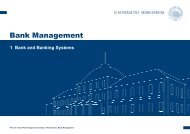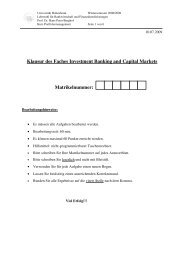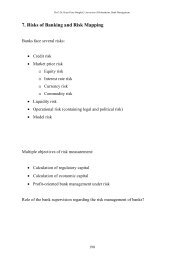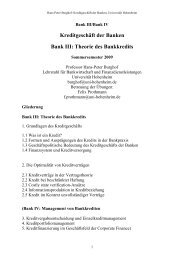Basics of Credit Risk - Universität Hohenheim
Basics of Credit Risk - Universität Hohenheim
Basics of Credit Risk - Universität Hohenheim
Create successful ePaper yourself
Turn your PDF publications into a flip-book with our unique Google optimized e-Paper software.
Investment Banking and Capital Markets – <strong>Universität</strong> <strong>Hohenheim</strong><br />
<strong>Basics</strong> <strong>of</strong> <strong>Credit</strong> <strong>Risk</strong><br />
Investment Banking and Capital Markets<br />
Winter 2009/10<br />
Chair for Banking and Finance Winter term 2009 Slide 1
Investment Banking and Capital Markets – <strong>Universität</strong> <strong>Hohenheim</strong><br />
Investment Banking and Capital Markets<br />
<strong>Risk</strong> associated with <strong>Credit</strong><br />
◮ Default risk<br />
◮ Market price risk<br />
What drives the market’s view <strong>of</strong> credit risk?<br />
◮ Rating changes<br />
◮ Balance sheet information<br />
◮ Implied equity volatility<br />
◮ new issuance activity<br />
◮ economic growth<br />
⇒ no chance <strong>of</strong> using simple models<br />
Chair for Banking and Finance Winter term 2009 Slide 2
Investment Banking and Capital Markets – <strong>Universität</strong> <strong>Hohenheim</strong><br />
Investment Banking and Capital Markets<br />
<strong>Credit</strong> <strong>Risk</strong> Models<br />
◮ Structural models<br />
◮ Go back to a seminal work <strong>of</strong> Robert Merton<br />
◮ default event if value <strong>of</strong> assets does not exceed the value <strong>of</strong> debt, equity’s<br />
worth zero<br />
◮ allows for the relative valuation <strong>of</strong> debt and equity → investment strategies<br />
◮ Reduced-form or intensity-based models<br />
◮ Default is not clearly defined<br />
◮ Error term which hits the company by accident<br />
◮ Default probability drawn from the traded credit spread<br />
◮ Transition matrix models<br />
◮ try to derive the probability <strong>of</strong> default from rating migrations<br />
◮ not very successful: rating transitions are just one price-driving factor<br />
◮ spreads for rating classes vary significantly<br />
Chair for Banking and Finance Winter term 2009 Slide 3
Investment Banking and Capital Markets – <strong>Universität</strong> <strong>Hohenheim</strong><br />
Investment Banking and Capital Markets<br />
Moody’s Definition <strong>of</strong> Default Events<br />
◮ A missed or delayed interest or principal payment, including payments<br />
made within a grace period<br />
◮ Filing for bankruptcy and related legal triggers that block the timely<br />
payments <strong>of</strong> interest or principal<br />
◮ Consummation <strong>of</strong> a distressed exchange<br />
Chair for Banking and Finance Winter term 2009 Slide 4
Investment Banking and Capital Markets – <strong>Universität</strong> <strong>Hohenheim</strong><br />
Investment Banking and Capital Markets<br />
A Single-Step, Two-Stage Model<br />
V risky<br />
◮ V risky : Value <strong>of</strong> the bond<br />
◮ PD: Probability <strong>of</strong> default<br />
◮ LGD: Loss given default<br />
1 - PD<br />
PD<br />
No Default<br />
V<br />
V Default<br />
LGD<br />
Chair for Banking and Finance Winter term 2009 Slide 5
Investment Banking and Capital Markets – <strong>Universität</strong> <strong>Hohenheim</strong><br />
Investment Banking and Capital Markets<br />
A Single-Step, Two-Stage Model (continued)<br />
◮ The expected loss is calculated by<br />
◮ EL: Expected Loss<br />
◮ Rec: Recovery rate<br />
EL = PD × LGD = PD × (1 − Rec) (23)<br />
◮ The value <strong>of</strong> the risky contract is therefore<br />
V risky = (1 − PD) × V No default + PD × V Default<br />
Chair for Banking and Finance Winter term 2009 Slide 6<br />
(24)
Investment Banking and Capital Markets – <strong>Universität</strong> <strong>Hohenheim</strong><br />
Investment Banking and Capital Markets<br />
A Single-Step, Two-Stage Model (continued)<br />
Rearranging yields<br />
V risky = V No default − PD × (V No default − V Default<br />
= V No default × [1 − PD × (1 −<br />
default<br />
V<br />
) ] (25)<br />
V No default<br />
| {z }<br />
Rec<br />
| {z }<br />
LGD<br />
| {z }<br />
EL<br />
Equation (25) is a well-known expression on credit risk<br />
Chair for Banking and Finance Winter term 2009 Slide 7
Investment Banking and Capital Markets – <strong>Universität</strong> <strong>Hohenheim</strong><br />
Investment Banking and Capital Markets<br />
A Multi-Step Model for Zero Coupon Bonds<br />
V risky<br />
0<br />
1 - p 1<br />
p 1<br />
No Default<br />
V1 V Default<br />
1<br />
= V risky<br />
1<br />
1 - p 2<br />
p 2<br />
Cash Flow Structure zero-coupon-bond<br />
No Default<br />
V2 = V terminal<br />
V Default<br />
2<br />
0 1 2<br />
◮ V risky<br />
i : Value <strong>of</strong> the risky claim at time i<br />
◮ V Default<br />
i<br />
: Value <strong>of</strong> the claim in the case <strong>of</strong> a default<br />
◮ pi: PD between i − 1 and i<br />
Chair for Banking and Finance Winter term 2009 Slide 8
Investment Banking and Capital Markets – <strong>Universität</strong> <strong>Hohenheim</strong><br />
Investment Banking and Capital Markets<br />
A Multi-Step Model for Zero Coupon Bonds<br />
◮ Expectation for V risky<br />
i<br />
or<br />
V risky<br />
0 = (1 − p1) × V<br />
V risky<br />
1 = (1 − p2) × V<br />
No default<br />
1<br />
No default<br />
2<br />
V risky<br />
0 = (1 − p1)(1 − p2)<br />
| {z }<br />
survival probability for two time steps<br />
+p1V default<br />
1<br />
+ p1 × V Default<br />
1<br />
+ p2 × V Default<br />
2<br />
+ (1 − p1)p2V default<br />
2<br />
No default<br />
V2 +<br />
Chair for Banking and Finance Winter term 2009 Slide 9
Investment Banking and Capital Markets – <strong>Universität</strong> <strong>Hohenheim</strong><br />
Investment Banking and Capital Markets<br />
A Multi-Step Model for Zero Coupon Bonds<br />
◮ Generalisation <strong>of</strong> the above<br />
◮ equidistant points in time τi with i = 1, . . . , n<br />
◮ pi is the PD between τi−1 and τi (if it has not defaulted before)<br />
◮ V risky<br />
i (m) indicates the value <strong>of</strong> a claim at time τi that runs until τm<br />
◮ and the survival rate<br />
S(m) =<br />
◮ note that S(m) = S(m − 1)(1 − pm)<br />
mY<br />
(1 − pi)<br />
Chair for Banking and Finance Winter term 2009 Slide 10<br />
i=1
Investment Banking and Capital Markets – <strong>Universität</strong> <strong>Hohenheim</strong><br />
Investment Banking and Capital Markets<br />
A Multi-Step Model for Zero Coupon Bonds<br />
◮ The unconditional probability <strong>of</strong> default between i − 1 and i is therefore<br />
◮ it follows that<br />
S(i − 1) − S(i) = S(i − 1) − S(i − 1)(1 − pi)<br />
V risky<br />
0 (m) = S(m)V terminal +<br />
= S(i − 1)(1 − (1 − pi))<br />
= S(i − 1)pi (26)<br />
mX<br />
i=1<br />
(S(i − 1) − S(i))V default<br />
i<br />
Chair for Banking and Finance Winter term 2009 Slide 11<br />
(27)
Investment Banking and Capital Markets – <strong>Universität</strong> <strong>Hohenheim</strong><br />
Investment Banking and Capital Markets<br />
A Multi-Step Model for Zero Coupon Bonds<br />
◮ The cumulative default probability is the complement <strong>of</strong> the survival<br />
probability<br />
Fi(m) = 1 − Si(m)<br />
◮ which is the cumulative default probability from t + τi to t + τm, and<br />
obviously<br />
Fi−1(i) = pi<br />
Chair for Banking and Finance Winter term 2009 Slide 12
Investment Banking and Capital Markets – <strong>Universität</strong> <strong>Hohenheim</strong><br />
Investment Banking and Capital Markets<br />
A Multi-Step Model<br />
◮ calculating with zero-coupon bonds is nice, but coupon bonds and other<br />
instruments (as CDS) have regular payments, thus<br />
V risky<br />
0<br />
1 - p 1<br />
p 1<br />
V risky<br />
V<br />
+<br />
1<br />
cf<br />
1<br />
V Default<br />
1<br />
1 - p 2<br />
p 2<br />
V risky<br />
V<br />
+<br />
2<br />
cf<br />
2 ...<br />
V Default<br />
2<br />
Cash Flow Structure coupon bond<br />
V risky<br />
V<br />
+<br />
m-1<br />
cf<br />
m-1<br />
1 - p m<br />
0 1 2<br />
m-1<br />
m<br />
◮ note the cash-flows in each period (coupon payments)<br />
...<br />
p m<br />
V cf<br />
m<br />
Default<br />
Vm<br />
Chair for Banking and Finance Winter term 2009 Slide 13
Investment Banking and Capital Markets – <strong>Universität</strong> <strong>Hohenheim</strong><br />
Investment Banking and Capital Markets<br />
A Multi-Step Model<br />
◮ The value <strong>of</strong> the claim in this case is<br />
◮ thus, we arrive at<br />
V risky<br />
i−1<br />
V0(m) =<br />
= (1 − pi)(V risky<br />
i<br />
mX<br />
i=1<br />
S(i)V cf<br />
i +<br />
mX<br />
i=1<br />
+ V cf<br />
i ) + piV default<br />
i<br />
(S(i − 1) − S(i))V default<br />
i<br />
(28)<br />
(29)<br />
which is the price <strong>of</strong> a central pricing relation for credit-risky instruments<br />
with multiple cash-flows, you can value regular bonds, zero coupon bonds,<br />
credit derivatives such as credit default swaps, and even portfolio<br />
derivatives such as collateralised debt obligations.<br />
◮ survival function and the recovery model necessary<br />
◮ if V default is independent <strong>of</strong> the time, the second term <strong>of</strong> (29) will collapse<br />
to (1 − S(m))V default<br />
Chair for Banking and Finance Winter term 2009 Slide 14
Investment Banking and Capital Markets – <strong>Universität</strong> <strong>Hohenheim</strong><br />
Investment Banking and Capital Markets<br />
Default Probability in a Continuous-Time Approach<br />
◮ τ ∗ : stochastic variable as the time until default<br />
◮ Ft(τ) = P(τ ∗ ≤ τ) St(τ) = P(τ ∗ > τ) with<br />
◮ Ft(0) = 0, lim Ft(τ) = 1, Ft(τ + ∆τ) ≥ Ft(τ) ∀ ∆τ > 0, and St(τ) =<br />
τ→∞<br />
1 − Ft(τ)<br />
◮ The default probability <strong>of</strong> the claim in the time frame τ to τ + ∆τ is<br />
Ft(τ + ∆τ) = P(τ ∗ ≤ τ + ∆τ)<br />
which is equivalent to<br />
= P(τ ∗ ≤ τ) + [1 − P(τ<br />
| {z }<br />
Ft (τ)<br />
∗ ≤ τ)]<br />
| {z }<br />
St (τ)<br />
· P(τ ∗ ≤ τ + ∆τ|τ ∗ > τ)<br />
| {z }<br />
probability for τ ∗ ∈[τ,τ+∆τ]<br />
St(τ) − St(τ + ∆τ) = St(τ) · P(τ ∗ ≤ τ + ∆τ|τ ∗ > τ) (30)<br />
Chair for Banking and Finance Winter term 2009 Slide 15
Investment Banking and Capital Markets – <strong>Universität</strong> <strong>Hohenheim</strong><br />
Investment Banking and Capital Markets<br />
Dealing with <strong>Credit</strong> <strong>Risk</strong><br />
◮ The default risk modeled before is tradable<br />
◮ The main instruments are<br />
◮ <strong>Credit</strong> Default Swaps (CDS),<br />
◮ <strong>Credit</strong> Linked Notes (CLN),<br />
◮ Indices on CDS, in Europe especially iTraxx and the very young SovX WE,<br />
◮ Total Return Swaps (TRS), and<br />
◮ Collateralised Debt Obligations (CDOs)<br />
Chair for Banking and Finance Winter term 2009 Slide 16
Investment Banking and Capital Markets – <strong>Universität</strong> <strong>Hohenheim</strong><br />
Investment Banking and Capital Markets<br />
<strong>Credit</strong> Derivatives – Market Participants<br />
End Users Application<br />
Asset Managers Diversify in credit risk<br />
Portfolio balancing tools<br />
Hedge funds Relative value trading<br />
Gaining leveraged exposure<br />
Proxy hedge against CDO tranches<br />
Circumspect trading strategies<br />
<strong>Credit</strong> correlation trading desks Proxy hedge against CDO tranches<br />
Gaining leveraged exposure<br />
Model trading<br />
Bank proprietary desks Trading and market-making credit books<br />
Chair for Banking and Finance Winter term 2009 Slide 17
Investment Banking and Capital Markets – <strong>Universität</strong> <strong>Hohenheim</strong><br />
Investment Banking and Capital Markets<br />
<strong>Credit</strong> Default Swaps – Basic Structure<br />
Chair for Banking and Finance Winter term 2009 Slide 18
Investment Banking and Capital Markets – <strong>Universität</strong> <strong>Hohenheim</strong><br />
Investment Banking and Capital Markets<br />
<strong>Credit</strong> Default Swaps – Market<br />
◮ Huge market, open position end <strong>of</strong> 2007: USD 60 trillion, today ca USD<br />
24 trillion<br />
70,000.00<br />
60,000.00<br />
50,000.00<br />
40,000.00<br />
30,000.00<br />
20,000.00<br />
10,000.00<br />
-<br />
<strong>Credit</strong> default swaps Outstanding, billions <strong>of</strong> USD<br />
1H01<br />
2H01<br />
1H02<br />
2H02<br />
1H03<br />
2H03<br />
1H04<br />
2H04<br />
1H05<br />
2H05<br />
1H06<br />
2H06<br />
1H07<br />
2H07<br />
1H08<br />
2H08<br />
1H09<br />
Chair for Banking and Finance Winter term 2009 Slide 19
Investment Banking and Capital Markets – <strong>Universität</strong> <strong>Hohenheim</strong><br />
Investment Banking and Capital Markets<br />
<strong>Credit</strong> Default Swaps – <strong>Credit</strong> Event Definition<br />
◮ Standardised products, easy to trade<br />
◮ Before the crisis: pure over-the-counter (OTC) product, now more and<br />
more clearing house usage<br />
◮ ISDA (International Swaps and Derivatives Association) issued the<br />
standardised “credit event” definition (1999/2003)<br />
1. Failure to pay<br />
2. Bankruptcy<br />
3. Restructuring<br />
4. Repudiation/moratorium (relevant to sovereign underlyings)<br />
5. Obligation acceleration<br />
6. Obligation default<br />
Chair for Banking and Finance Winter term 2009 Slide 20
Investment Banking and Capital Markets – <strong>Universität</strong> <strong>Hohenheim</strong><br />
Investment Banking and Capital Markets<br />
<strong>Credit</strong> Default Swaps – Settlement in the case <strong>of</strong> a credit event<br />
1. Physical settlement<br />
◮ Protection seller pays face value<br />
◮ Protection buyer hands over the reference obligation<br />
◮ Widely used, problems if the total value <strong>of</strong> the CDS exceeds the total value<br />
<strong>of</strong> the underlying entity (e.g. Delphi)<br />
2. Cash settlement<br />
◮ Protection seller pays<br />
P = 1 − (Rec + accrued interest on reference obligation)<br />
◮ Recovery rate is usually agreed upon in advance or estimated after the<br />
default<br />
◮ If recovery rate is fixed in advance: digital settlement<br />
Chair for Banking and Finance Winter term 2009 Slide 21
Investment Banking and Capital Markets – <strong>Universität</strong> <strong>Hohenheim</strong><br />
Investment Banking and Capital Markets<br />
<strong>Credit</strong> Default Swaps – An Example<br />
◮ Bank A has granted loans to corporations from the semiconductor<br />
industry, C1 and C2, USD 10mn each<br />
◮ High default correlation, A buys protection on C1 to lower overall risk<br />
◮ This costs 125bps per year on USD 10mn, or<br />
0.0125 · USD 10 000 000 = USD 125 000<br />
◮ To prevent negative cash-flows, the bank sells protection on a corporation<br />
with a low default correlation to the semiconductor industry. If the spread<br />
<strong>of</strong> this CDS is 125bps as well, the bank has diversified its portfolio for a<br />
cost <strong>of</strong> zero (+ fees)<br />
Chair for Banking and Finance Winter term 2009 Slide 22
Investment Banking and Capital Markets – <strong>Universität</strong> <strong>Hohenheim</strong><br />
Investment Banking and Capital Markets<br />
<strong>Credit</strong> Default Swaps – Basic Valuation<br />
◮ From the perspective <strong>of</strong> the protection seller:<br />
V CDS<br />
PS<br />
= V PL − V DL<br />
◮ the value consists therefore <strong>of</strong> a premium leg (PL) and a default leg (DL)<br />
◮ From the perspective <strong>of</strong> a protection buyer, it is obviously<br />
V CDS<br />
PB = −V CDS<br />
PS = V DL − V PL<br />
◮ The default leg usually consists <strong>of</strong> two components: the default payment<br />
and the accrued premium<br />
V DL = V DP − V AP<br />
Chair for Banking and Finance Winter term 2009 Slide 23<br />
(31)<br />
(32)<br />
(33)
Investment Banking and Capital Markets – <strong>Universität</strong> <strong>Hohenheim</strong><br />
Investment Banking and Capital Markets<br />
<strong>Credit</strong> Default Swaps – Basic Valuation<br />
◮ Discrete-time CDS pricing algorithm (market standard): JP Morgan model<br />
V (τm) =<br />
mX<br />
CFi · R(τi) · S(τi) +<br />
i=1<br />
| {z }<br />
V PL<br />
+<br />
mX<br />
CF default<br />
i<br />
· R(τi) · (S(τi−1) − S(τi))<br />
i=1<br />
| {z<br />
−V<br />
}<br />
DL<br />
◮ Note that this is a modification <strong>of</strong> (29), with a discount factor R<br />
◮ Needed: structure the premium payments CFi and the payment<br />
conditional on default, CF default<br />
i , the survival probability function S(τ);<br />
R(τi) can be derived by bootstrapping<br />
Chair for Banking and Finance Winter term 2009 Slide 24<br />
(34)
Investment Banking and Capital Markets – <strong>Universität</strong> <strong>Hohenheim</strong><br />
Investment Banking and Capital Markets<br />
<strong>Credit</strong> Default Swaps – Basic Valuation<br />
◮ With CFi being simply the product <strong>of</strong> ∆τ = τi − τi−1 and the contractual<br />
CDS rate c(τm)<br />
V PL =<br />
mX<br />
c(τm) · ∆τ · R(τi) · S(τi) (35)<br />
i=1<br />
◮ standard maturity days for CDS according to ISDA (2003): March 20,<br />
June 20, September 20, and December 20<br />
◮ ∆τ is usually three months<br />
Chair for Banking and Finance Winter term 2009 Slide 25
Investment Banking and Capital Markets – <strong>Universität</strong> <strong>Hohenheim</strong><br />
Investment Banking and Capital Markets<br />
<strong>Credit</strong> Default Swaps – Valuation<br />
◮ To determine V DL , we have to formalise the default payment (1 − Rec)<br />
and the accrued premium<br />
◮ To keep things simple, we assume that defaults occur in the middle <strong>of</strong> τi−1<br />
and τi, the accrual factor will be ∆τ<br />
: mid-point approximation<br />
2<br />
◮ Thus:<br />
V DP = (1 − Rec)<br />
V AP =<br />
mX<br />
i=1<br />
mX<br />
R(τi) · (S(τi−1) − S(τi)) (36)<br />
i=1<br />
c(τm) · ∆τ<br />
2 · R(τi) · (S(τi−1) − S(τi)) (37)<br />
Chair for Banking and Finance Winter term 2009 Slide 26
Investment Banking and Capital Markets – <strong>Universität</strong> <strong>Hohenheim</strong><br />
Investment Banking and Capital Markets<br />
<strong>Credit</strong> Default Swaps – Valuation<br />
◮ We arrive at the formula for the valuation <strong>of</strong> a plain-vanilla CDS-contract:<br />
V CDS = V PL − V DL = V PL + V AP − V DP<br />
=<br />
mX<br />
c(τm) · ∆τ · R(τi) · S(τi)<br />
i=1<br />
+<br />
mX<br />
i=1<br />
−(1 − Rec)<br />
c(τm) · ∆τ<br />
2 · R(τi) · (S(τi−1) − S(τi))<br />
mX<br />
R(τi) · (S(τi−1) − S(τi)) (38)<br />
i=1<br />
Chair for Banking and Finance Winter term 2009 Slide 27
Investment Banking and Capital Markets – <strong>Universität</strong> <strong>Hohenheim</strong><br />
Investment Banking and Capital Markets<br />
<strong>Credit</strong> Default Swaps – Valuation<br />
to be continued.<br />
Chair for Banking and Finance Winter term 2009 Slide 28
Investment Banking and Capital Markets – <strong>Universität</strong> <strong>Hohenheim</strong><br />
Investment Banking and Capital Markets<br />
Literature<br />
◮ Merton, R. (1974): On the Pricing <strong>of</strong> Corporate Debt: The <strong>Risk</strong> Structure<br />
<strong>of</strong> Interest Rates, The Journal <strong>of</strong> Finance, 29, pp. 449-470<br />
◮ Felsenheimer, J., and Gisdakis P., Zaiser, M. (2006) Active <strong>Credit</strong><br />
Portfolio Management, Wiley-VCH, Weinheim, ch 7, 10<br />
Chair for Banking and Finance Winter term 2009 Slide 29



